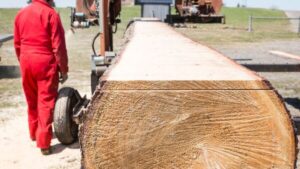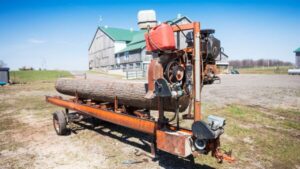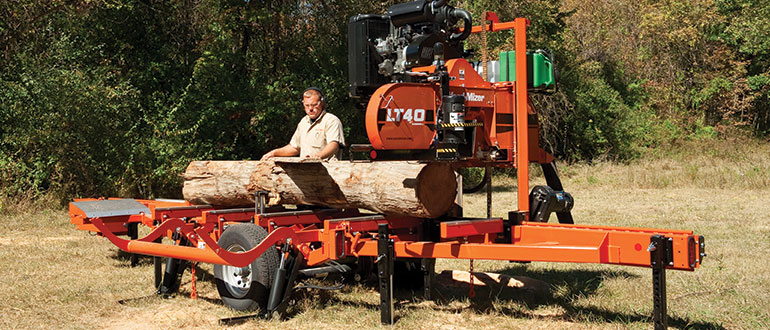A portable bandsaw mill is a great option for it offers higher productivity and less manual labor compared to chainsaw and pitsaw mills. Once you bought your sawmill, the next step is setting it up for operation. This part may seem enjoyable at the same time frustrating especially if you’re not so familiar with the steps and tools to be used.
Setting up a bandsaw mill might take around 30 minutes to an hour depending on the skills and knowledge of the person. Likewise, if there’s an extra person, the job should go much quicker.
If you don’t have much knowledge about it, it’s a good thing you came to our place as we’ll guide you through the process of setting it up.
Let’s start. Simple and easy tips and techniques
What Tools Do I Need To Have On Hand?
The general tools you will be used in setting up your portable bandsaw mill include a carpenter’s level, push-pull rule, Allen wrench, carpenter’s square and screwdriver. The setup process can be subdivided into five steps: levelling the track, squaring up log stops, blade tracking, blade guides, and squaring the blade.
Levelling the Track
It’s greatly important to secure the machine is placed on a flat plane for during operation it constantly vibrates. This secures a flat smooth cut on your timber.
To ensure your portable bandsaw mill is on flat ground you can use a carpenter’s level. Place the level on the surface of the front, back, left and right sides of the machine. Make sure the bubble falls within the centre portion of the level.
Squaring Up Log Stops
Bandsaw mills can either have a welded fixed or adjustable backstops. For adjustable backstops, you can use a carpenter’s square or level to check if it’s balance or perpendicular to the surface. If unbalanced, loosen up the lockdown at the bottom using an Allen wrench and adjust the set screw using a screwdriver.
Blade Tracking
In this step, you need to make sure your blade is up to full tension as recommended by the manufacturer. Some bandsaw mill also has some tracking screws which you can adjust using an Allen wrench.
Blade Guide
A bandsaw mill can either have a ceramic fixed guide or an adjustable roller guide. Move the blade and check if there are any squeaking sounds as it passes through the blade guide. If it makes a sound, that means the guide is a little bit off and needs adjustments. Adjust the front, bottom, back of the guide by loosening and tightening the set screws using an Allen wrench.
Squaring the Blade
Once you’re done with all the previous steps, the last thing to do is running a piece of log to see if it makes a perfect square cut. If one side is a little off, measure the distance from the top of the bunk towards the bottom of the blade using a push-pull rule. Then adjust the height of the blade.
Can I Leave The mill Attached to My Truck While I Saw?
This machine goes into medium to strong vibrations when operating. It is advisable to just detach the whole unit from the truck and set it up on flat ground where it will maintain stability or fewer vibrations.
How Long Does it Take to Saw an Average 20 feet Log?
This one will refer to the bandsaw surface feet per minute (SFPM or SFM) or simply the cutting speed of the unit. The factors affecting cutting speed include motor power, the diameter of the pulley and the band wheel.
In order to increase productivity, SFM must be increased but there’s also a tendency that torque decreases with increasing speed. The lower the blade speed entails more torque applied which is good for harder woods.
The recommended bandsaw speed is within 40 feet (12 m) per minute to 5,000 feet (1,500 m) per minute. Whereas customized saws for friction cutting of hard metals can run up to 15,000 feet per minute. Hence, a 20 feet log can be sawn in minutes only with a bandsaw mill running at 40 feet per minute.

Meanwhile, getting the right tension for your blade is needed to minimize blade deflection. In order to secure precise straight cuts, one needs to apply enough blade tension to hold the blade in place while cutting through the lumber. This ensures good quality timber and increases productivity. Typically, most manufacturers would suggest a pressure between 15,000 to 20,000 psi to hold a carbon-steel blade to lessen blade deflection.
Uses For The Band Saw Dust, Can I Sell It?
Sawdust is one of the major by-products for any milling industry. There are a lot of things you can do to earn and recover from this by-product.
Currently, it has three main options for usage namely as an energy resource, raw material for other manufacturing industries, and as a fertilizer component in the agriculture centres.
In 2010, sawdust is sold at approximately $45 per dry ton while it went up to $50 in 2015. For retailing, its price is around $5 to $15 per bag while for bulk orders it ranges from $2 to $6 per pound.
Here are three main uses of sawdust:
Energy Source
The scarce resource for fuel led to the utilization of this material as wood gas. The sawdust is converted to briquettes which is a good alternative fuel source. Likewise, this material is also good for thermal insulation in refrigerating systems or cold storage facilities.
Manufacturing Industries
Another application of sawdust is in the field of paper and pulp making. It serves as a good raw material for the production of particle board, water board, plywood board and other light furniture materials.
Agricultural Industries
This by-product has also been used as a fertilizer component called as sawdust compost. It is used for mulches, small fruit growers and plant nurseries. The lack of organic matter in most soils in the world craves for the need for this material. When added into the soil, it increases water absorption and retention.
Lastly, it’s also used as an Animal Bedding Material.
Sawdust is one of the material options used for animal bedding. It is a variable material but some are discouraged to use for the following reasons:
- Tedious screening and drying process before using as bedding material
- It can easily get dusty which may harm farm staff
- It readily absorbs moisture and a damp sawdust becomes a good growing medium for pathogens
Can You Make Money Sawing For Other People?
The increasing demand for timber all over the world poses a good opportunity to be in this business. Like any other businesses, one must also abide by the government rules and regulations imposed for this industry in order to strike balance between profitability and sustainability.

Important Factors for Running a Small Sawmill Business
- Do market research on the in-demand timber products in your locale
- Research as well on the supply of trees nearby
- Don’t just by cheap logs, choose a log which you really need
- Establish and maintain a good rapport with your supplier
- Ensure good log inventory management
- Get certifications for quality to establish competitiveness
- Get your lumber graded
- For custom-saw, charge by the hour and not by the board foot
- Invest in good kiln drying
- Have a good marketing plan for the business
- Maintain a good warehouse to store your timbers and keep them dry
Conclusion
Portable Bandsaw mill requires a higher investment than chainsaw mills but it gives you higher productivity compared to the other. You have a guaranteed cost-effective operation when using a bandsaw compared to other machine types. Aside from its sweet side, some of the setbacks for this unit include higher maintenance cost and larger workspace requirement.
Keep in mind, the productivity of any sawmill depends on a variety of factors such as mill type, engine size or motor power, log supplies, labor force, capital, and logistics. These things need to be carefully observed to determine which drives your operation up or down.
Hopefully, you have learned a lot about bandsaw mills in our place. If you want to learn more, just read and access our other articles.
For inquiries, comments, suggestions or help, please don’t hesitate and contact us at any time. We’ll be happy to be there to cater to your needs.

